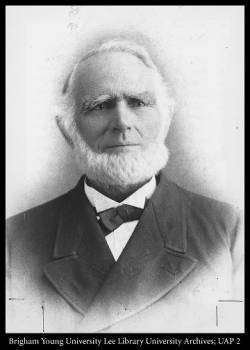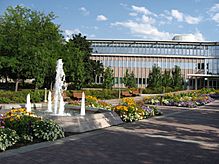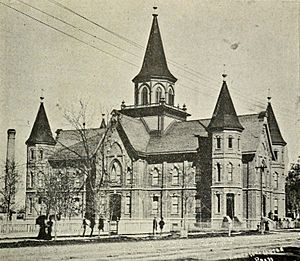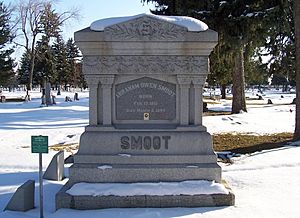Abraham O. Smoot facts for kids
Quick facts for kids
Abraham O. Smoot
|
|
|---|---|
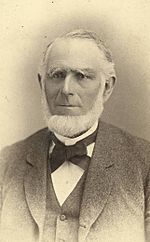
Photo of A. O. Smoot by C. R. Savage
|
|
| Born |
Abraham Owen Smoot
February 17, 1815 |
| Died | March 6, 1895 (aged 80) |
| Monuments | Smoot Administration Building, Brigham Young University |
| Nationality | American |
| Title | Mayor of Salt Lake City, Utah; Mayor of Provo, Utah |
| Term | 1857-1866; 1868-1881 |
| Predecessor | Jedediah M. Grant |
| Successor | Daniel H. Wells |
| Spouse(s) | Margaret Thompson McMeans Sarah Gibbens Emily Hill Diana Caroline Tanner Eldredge Anne Kirstine Mauritsen Hannah Caroline Rogers |
| Children | 24 (biological) 11 (adopted) |
Abraham Owen Smoot (February 17, 1815 – March 6, 1895) was an important American pioneer, businessman, and leader. He was also a politician. He spent his early life in the southern United States. He was one of seven children in his family.
After joining The Church of Jesus Christ of Latter-day Saints (LDS Church), Smoot became a missionary. He served in Kentucky, Tennessee, South Carolina, and England. He didn't go to school much as a child. But he learned to read and later attended a special school called the School of the Prophets. Like other early members of the LDS Church, Smoot married several women. He had six wives and 24 children.
Later, he moved west to Utah Territory. He was elected the second mayor of Salt Lake City. He held this job from 1857 to 1866. Then, Brigham Young asked him to move to Provo. There, he became a church leader and mayor from 1868 to 1881. He helped pay for the Provo Tabernacle (now the Provo City Center Temple). He also helped build the Utah Southern Railroad.
Smoot was the first president of the board of trustees for Brigham Young Academy (BYA). This school later became Brigham Young University (BYU). He gave a lot of money to the school. People called him the "foster father" of the Academy. He wanted to make sure young Latter-day Saints could get an education. Today, the Smoot Administration Building at BYU is named after him.
Contents
Early Life and Faith
Abraham Owen Smoot was born on February 17, 1815. His hometown was Owenton, Kentucky. His parents were George W. Smoot and Nancy Ann Smoot. His family had roots in Scotland, Ireland, and England. He had two brothers and five sisters. His family moved twice when he was a child. They first went to southwestern Kentucky. Then they moved to Tennessee.
As a young boy, he worked on a farm. He did not go to school. His father died in 1828 when Abraham was nine. His mother later remarried. His mother's family, the Rowletts, taught him to read. This was very important because there were few schools nearby.
In 1835, Abraham's mother joined the Church of Christ. Abraham joined too on March 22, 1835. Warren Parrish baptized him. David W. Patten confirmed him as a member. Smoot had always wondered if God had a church on Earth. When he heard Parrish and Patten preach, he felt he had found the answer. Soon after, Smoot led a small group of church members. He became friends with Wilford Woodruff. Woodruff helped him get ready for missionary work. They went on a short mission together. Then they traveled to Kirtland, Ohio. There, they attended the School of the Prophets. This experience showed Smoot how important education was. While in Kirtland, Smoot met Joseph Smith. He also saw ancient papyrus scrolls.
Missions and Challenges
On February 4, 1836, Smoot became an elder. He started preaching in Kentucky and Tennessee. This first mission lasted nine months. He met people who were against his beliefs. But he also met many who wanted to join the church. He continued to lead the church group in his hometown.
Joseph Smith asked Smoot to gather people from Tennessee. They were to move to Far West, Missouri. Smoot brought his family and about 200 other people. He helped them settle in Daviess County, Missouri. He also helped survey the Adam-ondi-Ahman valley. In 1838, he went on a five-month mission. He preached in southern Missouri and Arkansas. When he returned, Missouri state forces arrested him. This happened on November 1, 1838, during the 1838 Mormon War. Joseph Smith and Hyrum Smith were also arrested.
After being released, Smoot moved to Zarahemla, Iowa. He became a member of the high council. In 1842, Smoot went on another mission to South Carolina. He preached in Charleston. But he did not find success there. He returned to Nauvoo, Illinois that July. During Joseph Smith's 1844 presidential campaign, Smoot worked in Tennessee. He helped with both political and missionary efforts. While preaching, he faced people who opposed him. Once, a man tried to shoot him. The bullet missed his head. Another time, a mob of 200 men threatened him. But some people in the audience protected him. Smoot later wrote that God had saved his life many times. When he heard about the deaths of Joseph and Hyrum Smith, he returned to Nauvoo. He then led a church group in Keokuk, Iowa. In 1844, he served another mission in Alabama. He gathered a group from there to move west. Between missions, Smoot was a police officer in Nauvoo. He also worked in the Nauvoo Temple.
In 1851, Smoot went on a mission to England. His goal was to help new church members move to the United States. He helped them travel west. He got sick with cholera during the journey. But he recovered. The group arrived in Utah in September 1852. In total, Smoot served nine missions. He also served as a bishop twice.
In 1880, at age 65, Smoot went to the Hawaiian Islands. This was for a church mission and to improve his health. In Hawaii, he met King Kalakaua. He taught the king about his faith. His son, Reed Smoot, wrote that his father was very active there.
Family Life
In 1838, Smoot began writing to Margaret Thompson McMeans Adkinson. She was a widow. He married her on November 11, 1838. This happened while he was a prisoner of war. Margaret had a son named William from her first marriage. Smoot adopted him. Margaret was very dedicated to her religion. She supported Smoot's decision to marry more women.
On January 9, 1846, Smoot married his second wife, Sarah Gibbens. He then married his third wife, Emily Hill. Both marriages were approved by Margaret. Emily Hill was a widow with two children. In 1847, Emily gave birth to Smoot's first biological child, Albert. She later had three more children. Sarah Gibbens did not move to Utah. She later divorced Smoot.
In 1855, Smoot married Diana Tanner Eldredge. The next year, he married Anne Kirstine Mauritsen. She was an immigrant from Norway. Diana had thirteen children. Anne had seven children. He later married Hannah Caroline Rogers in 1886.
Smoot had 24 biological children with three of his wives. These included Reed Smoot, who became a US Senator. Another son, Brigham Smoot, was a missionary. His daughter, Ida Smoot Dusenberry, was a leader in the Relief Society. He also adopted eleven children. Many of them were his wives' children from previous marriages. Smoot was a strict father. He taught his children Christian values. He wanted them to be strong believers. His children remembered him as a stern but loving father.
Journey West
Abraham Smoot could not leave Nauvoo, Illinois, with the first group of pioneers. He and a large group of friends from the South started their journey west in May 1846. Two of his wives, Margaret and Emily, traveled with him. By July, the group reached Council Bluffs, Iowa. There, Smoot was called to be a bishop. He was ordained in January 1847. This happened when the group reached Winter Quarters, Nebraska. He joined other pioneers there.
Smoot was chosen to lead a group of one hundred families. This group had 120 wagons. He guided his group of 317 people on their journey west. Smoot's group arrived in Utah in September 1847. They were the second group of pioneers to reach the Salt Lake Valley.
Views on Slavery
Abraham Smoot's family in the South had owned slaves. He also owned slaves in the Utah territory. However, as a missionary, he supported Joseph Smith's plan. This plan called for slavery to end slowly over time. On a mission to Tennessee, Smoot tried to print copies of Smith's plan. But the printer refused. It was against the law to share anti-slavery writings in that state.
In Utah, Abraham and Margaret Smoot owned at least two men and one girl as slaves. One of them, Tom, died in 1862 while still enslaved. Some historians say Smoot, along with other leaders, was among the few in Utah who supported slavery.
Leadership in Utah
Salt Lake City Leader
Smoot led groups of pioneers to the Salt Lake Valley in 1847, 1852, and 1856. In Salt Lake City, he served as a bishop for the LDS Church. He was also Utah Territory's first elected justice of the peace. Smoot started a business with others. It was called the Great Salt Lake Valley Carrying Company. This company transported goods and people across the Great Plains. This happened during the California Gold Rush. Smoot himself led thirteen of these trips. He also served as an alderman (a city council member) from 1854 to 1857.
In 1857, Smoot was elected the second mayor of Salt Lake City. He became mayor after the first mayor, Jedediah M. Grant, died. Smoot was re-elected and served as mayor until 1866. During this time, he was also a bishop in Salt Lake City. After being mayor, he served for twelve years in the upper house of the Utah legislature.
Provo and Brigham Young Academy
In early 1868, Brigham Young asked Smoot to be a church leader in Provo. Young wanted Smoot to help unite the church members there. Smoot was hesitant at first. He had served the church for over 30 years. He wanted to enjoy his successful businesses. But he believed that church service came before his own interests. He moved to Provo with his family in February 1868.
Within his first week in Provo, Smoot was elected mayor. He held this job until 1881. His motto as a leader was: "Ye Elders of Israel, know that ye are right and then go straight ahead." He reportedly did not get paid for his public service. Under his leadership, the Utah Southern Railroad was built. Many streets and the Provo Tabernacle were also built. Smoot gave his own money to the Tabernacle. He also worked to raise money from the community. He was a major investor in the Provo Woolen Mills. He became president of that business. Smoot also helped start and lead the First National Bank of Provo. He also led the Provo Lumber Manufacturing and Building Company.
Smoot was the first president of the board of trustees for Brigham Young Academy (BYA). He served from 1875 until his death in 1895. He made large financial contributions to BYA. These contributions helped the school keep running. The number of students grew from 70 to 313 during his time. BYA later became Brigham Young University (BYU). Today, BYU's administration building is named after Smoot.
Smoot faced heavy debts from building the Provo Tabernacle and the Academy. He was personally responsible for these debts. He used his own property to help the school. In January 1884, a fire destroyed the building where BYA operated. Smoot quickly arranged for school to continue that evening. Only one day of school was lost. He asked the church for financial help many times. But he did not receive it during his lifetime. After Brigham Young died, people often called Smoot BYA's "foster father." Smoot had limited formal schooling. But he wanted his children and all church children to have good educational opportunities.
Death and Legacy
Abraham Smoot died on March 6, 1895, in Provo, Utah. He had just celebrated his 80th birthday. His health had gotten worse after he was hit by a falling tree in 1893. Smoot's funeral was held on March 10, 1895. It took place in the Provo Tabernacle. People called it "the most impressive ever witnessed in pioneer Utah territory." Many important church leaders attended. Speakers included George Q. Cannon, Joseph F. Smith, and Wilford Woodruff. The funeral had the largest attendance seen in Provo. Woodruff said Smoot's funeral procession was the longest he had ever seen in Utah. Smoot was survived by two of his wives and nineteen of his children.
In 1962, BYU's administration building was named after Smoot. In 2015, he was honored at BYU's homecoming events. In 1994, it was reported that Smoot had over 3,000 descendants. He has been called "one of the most prominent and influential men in the history of the State [of Utah]." A collection of 257 documents about Smoot's life is kept at BYU's Harold B. Lee Library. These include his journals, letters, and mission calls.
See also
 In Spanish: Abraham O. Smoot para niños
In Spanish: Abraham O. Smoot para niños


